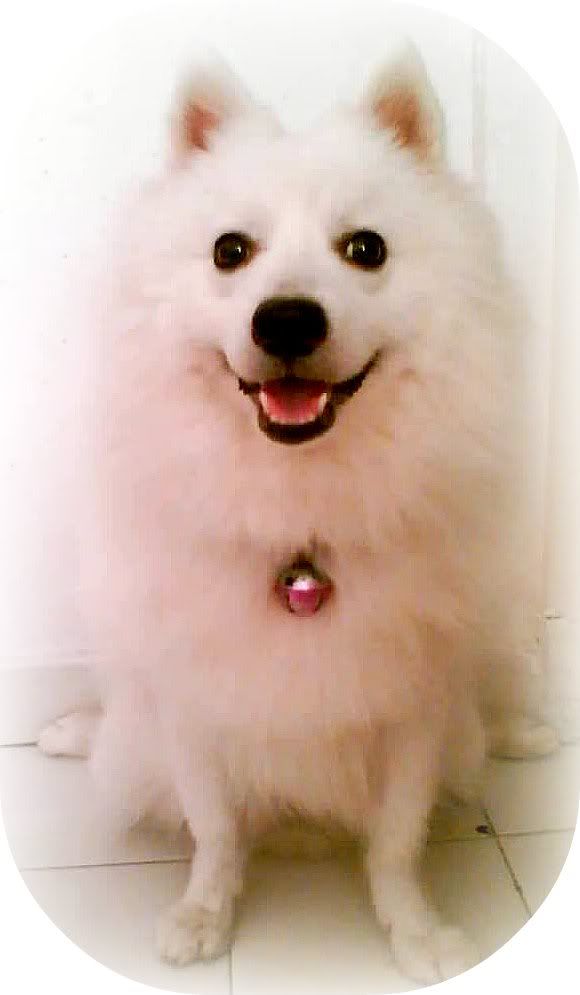 A typical day for beautiful golden Labrador retriever, Kendra, is waking up next to her loving master, followed by donning her full regalia of harness, leash, and ID tags, which reveals her professional role.
A typical day for beautiful golden Labrador retriever, Kendra, is waking up next to her loving master, followed by donning her full regalia of harness, leash, and ID tags, which reveals her professional role.
Kendra is a professional guide dog, and her job is to guide her master to various places—office, lunch, and the gym among others.
She is extensively trained from the tender age of two months old to be well behaved while at work as well as confidently and safely assist her master in crossing busy traffic junctions and through crowded sidewalks and shopping malls. Kendra and her master travel all over our sunny island on buses, trains, taxis, and even on board a plane at times. When they are not on the move, Kendra quietly tucks herself under Mr Kua’s chair and takes a little snooze to recharge for the next adventure.
Kendra, however, is currently a rare sight in Singapore. She is the only guide dog in Singapore now. Kendra is a generous donation from The Guide Dogs for the blind INC. (GDB) based in America, who hopes to see mobility of Singaporean visually impaired improve through the use of guide dogs.
But thanks to The Guide Dogs Association of the Blind in Singapore (GDAB), Kendra would not be alone much longer. Arrangements are currently made for more guide dogs to arrive in the coming months.
Kendra’s owner, also a founding member of GDAB, Mr. Kua  Cheng Hock said: “A guide dog exponentially enhances the safety and independence of a visually impaired individual.”
Cheng Hock said: “A guide dog exponentially enhances the safety and independence of a visually impaired individual.”
He added: “Guide dogs are especially important in Singapore as our fast pace of life often means family members or passersby do not have the time to help a sight challenged person cross the road or get to the place he or she would like to go.”
Mr. Kua is deeply passionate about helping fellow visually challenged individuals be able to lead independent and more productive lives. He has been campaigning for the lawful use of guide dogs by the visually impaired in Singapore for more than three decades.
In 1982, Mr. Kua brought an Australian trained guide dog to Singapore but had to return it, as the culture here, such as establishments and public transport, was extremely unreceptive of a guide dog. Saddened but not discouraged, Mr. Kua continued to lobby for improvements in public areas for the use of guide dogs so that the visually impaired of Singapore may better travel about.
Finally, in 2005, Mr. Kua came together with a few philanthropic friends bound by their love of dogs and their compassion for the visually impaired, and formed GDAB. Their vision is to provide a high level of quality care for the visually impaired by providing a trained guide dog for suitable individuals, as well as to make changes in our environment to integrate guide dogs. The GDAB also hopes to raise funds for professionally trained mobility instructors to provide continual support to beneficiaries and their guide dogs after training.
Since 2005, GDAB has improved the infrastructural support for the use of guide dogs in Singapore. For one, they obtained approval from the authorities, allowing guide dogs to live in HDB flats (public housing), where usually only small dogs are allowed as pets. Also, through GDAB’s continuous lobbying, guide dogs are now exempted from legislations that prohibit the entry of animals into food establishments and onto public transport.
Nonetheless, more doors need to be opened for the ease of guide dogs use in Singapore. GDAB still has much work ahead of them as they aim to make Singapore a friendlier city for the visually impaired. Currently, some of GDAB’s projects are working on raising awareness in the general public through school and community talks as well as visiting businesses and service providers like hotels and hospitals all over the country to invite them to be guide dogs-friendly establishments.
According to Mr Kua, the challenges of having a guide dog now are similar to that of 28 years ago. Although media interviews have helped broaden awareness and access to guide dogs here has improved, there is still much to be done to educate the public about the legislation in order to ease the use of guide dogs in Singapore.
For example, people are still afraid that guide dogs may bite them and taxi drivers fear that guide dogs may dirty their taxis. All these misperceptions are largely due to lack of awareness—the general public would often label a guide dog as just another pet. Most are unaware that guide dogs are even better behaved as they are professionally trained to help enhance the lives of their visually impaired owners.
In the past, Mr Kua, a very active sportsman, was reluctant to visit the gym in fear that it would inconvenience others who might worry for his safety. Because of the many fitness equipments there, people would often stop their work out fearing Mr Kua’s white cane would get caught and he would fall or jam the equipment.
Now with the help of Kendra, he could now confidently and safely make his way around them in the gym. Additionally, his social life blossomed whiles taking Kendra downstairs to relieve herself—he got to know more of his neighbours.
 There looks to be a happy ending for Mr. Kua’s dream of enabling the visually impaired to enjoy life better through the use of guide dogs. Now, in partnership with the guide dogs school in America and with the expertise of GDAB’s board members, which includes veterinarians, opthalmologists and lawyers, what was once a dream is slowly but surely turning into reality.
There looks to be a happy ending for Mr. Kua’s dream of enabling the visually impaired to enjoy life better through the use of guide dogs. Now, in partnership with the guide dogs school in America and with the expertise of GDAB’s board members, which includes veterinarians, opthalmologists and lawyers, what was once a dream is slowly but surely turning into reality.
To find out more or if you wish to lend a helping hand to GDAB, please visit GDAB at http://www.guidedogs.org.sg/.
Source: http://www.seforum.sg/2010/05/23/my-dog-my-companion-my-guide/









































 Glitterfy.com - Glitter Graphics
Glitterfy.com - Glitter Graphics
No comments:
Post a Comment